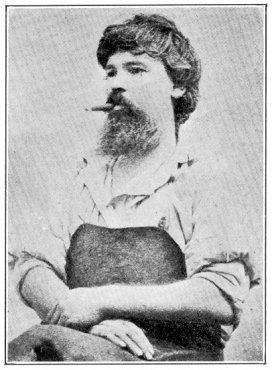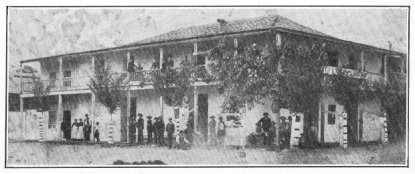
[click to enlarge]
Francisco Bruschi,
Coulterville pioneer.
| Online Library: | Title | Author | California | Geology | History | Indians | Muir | Mountaineering | Nature | Management |
Yosemite > Library > Call of Gold > 29. John Muir, World-Famous Naturalist >
Next: 30. Benefactor Diltz • Contents • Previous: 28. Fremont’s Later Career
On March 28th, 1868, John Muir, in his search for wild places, started from San Francisco, for Yosemite Valley, in Mariposa County. He walked leisurely through the Santa Clara Valley, over the Pacheco Pass, crossed the San Joaquin River at Hills Ferry, followed the Merced River to Snelling, then ascended the foothills to Coulterville, then to Bower’s Cave, Crane Flat and into Yosemite, where he spent eight or ten days, which included a visit with Galen Clark at Wawona. He was so charmed with the beauties of Yosemite that he returned the following Spring as a herder of sheep, in order to again visit the treasures he had sampled. “Wherever we go in the mountains”, he said, “or indeed, in any of God’s fields, we find more than we seek.”
He remained a resident of Yosemite from 1869 to the latter part of 1874. The leading geologists, at that time, including Josiah Dwight Whitney, claimed that the Yosemite Valley had been formed by a process of upheaval. Muir opposed this view as early as 1870, believing that the mighty cavity had been boldly sculptured by glacier action, the ice having even over-ridden Glacier Point. He helped to prove this theory to the world and it is now the generally accepted one as to the forming of Yosemite Valley.
He was born of very religious parents, April 21, 1838, in Dunbar, Scotland. He started to school at the age of three. At eleven years of age, he had committed to memory, three-fourths of the Old Testament and all of the New Testament. In 1849, he came to America with his parents, who pioneered on a farm in Wisconsin, where John experienced plenty of hard work. He read all the books available, which included “Ancient History”, by Charles Rollin, Josephus’ “War of the Jews”, d’Aubigne’s “History of the Reformation”, Wood’s “Natural History”, Thomas Dick’s “Christian Philosopher”, Campbell’s and Akenside’s works and

[click to enlarge] Francisco Bruschi, Coulterville pioneer. |

[click to enlarge] The original Jeffrey Hotel, Coulterville. |
All through life, he loved the wildness of Nature, and when a young man, showed an aptitude for mechanics. He spent four years at the University of Wisconsin, leaving there in June, 1863, in order to travel and learn more about botany. He became world-famous as a geologist and discovered Muir Glacier in Alaska. He devoted many years to the cause of forest preservation and his writings were to a great degree responsible for the making of Yosemite a National Park. Lovers of nature will find inspiration by carefully reading his published works.
John Muir introduced to the world the water ouzel, the only wild bird in the Yosemite region, that sings in the winter time. Plump and compact as a pebble, about the size of a robin, bluish-gray in color, with a tinge of chocolate on head and shoulder, it builds its nest near the waterfalls or swift flowing streams and although of land-dwelling ancestry, it had adapted itself to gaining its livelihood in the water.
He says: “Find a fall, or cascade, or rushing rapid, anywhere upon a clear stream, and there you will surely find its complimentary ouzel, flitting about in the spray, diving in foaming eddies, whirling like a leaf among the beaten foam bells; ever vigorous and enthusiastic, yet self-contained, and neither seeking nor shunning your company. Among the mountain birds, none has cheered me so much in my lonely wanderings, none so unfailingly. For both in winter and summer, he sings, sweetly, cheerily, independent of sunshine or of love, requiring no other inspiration than the stream, in which he dwells. While water sings, so must he, in heat or cold, calm or storm, ever attuning his voice in sure accord; interpreting all that we, in our unbelief, call terrible in the utterances of torrents and storms, as only varied expressions of God’s eternal love.”
Next: 30. Benefactor Diltz • Contents • Previous: 28. Fremont’s Later Career
| Online Library: | Title | Author | California | Geology | History | Indians | Muir | Mountaineering | Nature | Management |
http://www.yosemite.ca.us/library/call_of_gold/john_muir.html